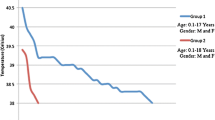Summary
Percutaneous endoscopic gastrostomy (PEG) has had a significant impact on enteral alimentation in patients unable to maintain adequate oral caloric intake. PEG avoids the morbidity and mortality associated with the traditional feeding gastrostomies placed by celiotomy. Several authors have documented benign, self-limiting pneumoperitoneum following PEG placement. No study has addressed whether the timing of panendoscopy in relation to gastric puncture has an effect on the incidence of post-PEG pneumoperitoneum. The authors prospectively studied 30 patients undergoing PEG. Panendoscopy was either performed before or after gastric puncture, and each patient then had abdominal radiographs to determine the presence of pneumoperitoneum. Four of 16 patients (25%) having panendoscopy prior to gastric puncture had radiographic evidence of pneumoperitoneum compared to three of 14 patients (23%) having panendoscopy following gastric puncture. The authors conclude that the timing of panendoscopy in relation to gastric puncture does not significantly effect the incidence of post-PEG pneumoperitoneum.
Similar content being viewed by others
References
Bryant L, Wiot J, Kloecker R (1963) A study of the factors affecting the incidence and duration of postoperative pneumoperitoneum. Surg Gynecol Obstet 117: 145–150
Gauderer M, Ponsky J (1980) Gastrostomy without laparotomy: a percutaneous endoscopic technique. J Pediatr Surg 15: 872–875
Gottfried E, Plumser A, Clair M (1986) Pneumoperitoneum following percutaneous endoscopic gastrostomy: a prospective study. Gastrointest Endosc 32: 397–399
Hillman K (1982) Pneumoperitoneum—a review. Crit Care Med 10: 476–481
Madura M, Craig R, Shields T (1982) Unusual causes of spontaneous pneumoperitoneum. Surg Gynecol Obstet 154: 417–420
Mellinger J, Schonholz S, Ponsky J (1990) Endoscopic techniques for enteral access and alimentation. Probl Gen Surg 7: 147–160
Plumser A, Gottfried E, Clair M (1984) Pneumoperitoneum after percutaneous endoscopic gastrostomy. Am J Gastroenterol 79: 440–441
Ponsky J, Gauderer M (1981) Percutaneous endoscopic gastrostomy: a nonoperative technique for feeding gastrostomy. Gastrointest Endosc 27: 9–11
Schnall H, Falkenstein D, Raicht R (1987) Persistent pneumoperitoneum after percutaneous endoscopic gastrostomy. Gastrointest Endosc 33: 248–250
Stassen W, McCullough A, Marshall J, Eckhauser M (1984) Percutaneous endoscopic gastrostomy: another cause of “benign” pneumoperitoneum. Gastrointest Endosc 30: 296–298
Strodell W, Lemmer J, Eckhauser F, Botham M, Dent T (1983) Early experience with endoscopic percutaneous gastrostomy. Arch Surg 118: 449–453
Wills J, Oglesby J (1983) Percutaneous gastrostomy. Radiology 149: 449–453
Author information
Authors and Affiliations
Rights and permissions
About this article
Cite this article
Pidala, M.J., Slezak, F.A. & Porter, J.A. Pneumoperitoneum following percutaneous endoscopic gastrostomy. Surg Endosc 6, 128–129 (1992). https://doi.org/10.1007/BF02309084
Issue Date:
DOI: https://doi.org/10.1007/BF02309084




